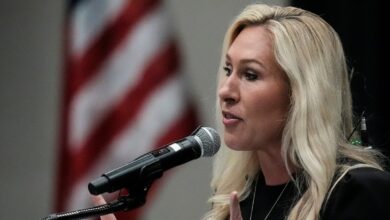Opinion | ‘Our 2028 Nominee Will Need to Come From America, Not Washington’

But, he countered,
How do you de-Brahminize a Brahmin Left party that’s been evolving in the Brahmin direction for decades? Some Democrats seem to think it’s just a matter of playing the economic populist card as in: ‘Hey working class, over here, we love you and will fight for your interests against the billionaire class and their despicable Republican handmaidens!’ Then the working class will realize the Democrats are their party and all will be well.
This is not remotely plausible. You cannot undo the damage of decades of Brahminization by simply asserting you are something so many working-class voters think you are not: the tribune of the working class.
How, then, can the party break through “Brahminization”?
Teixeira:
Just as Trump shook up the Republican Party and decisively changed its image and political base, Democrats need a political entrepreneur who will shake up the Democratic Party and decisively change its Brahmin Left trajectory.
That entrepreneur will have to be unafraid of the professional class blowback (accusations that you are racist, sexist, transphobic, a bigot, MAGA-lite, etc.) that will inevitably arise and aggressively push back against that class and its priorities.
In short, Democrats need a class traitor — a politician who’s not afraid to ask Democrats who the social justice they prize so highly is really for. Is it really for the poor and working class who have the short end of the stick in our society or is it to make Democrats feel righteous and onside with Team Progressive?
Doug Sosnik, White House political director and senior adviser for policy and strategy during the Clinton administration, elaborated on the themes raised by Teixeira in a 2023 analysis, “The Road to A Political Realignment in American Politics,” published by Politico.
“Demographics and economics,” Sosnik wrote,
have long driven voting patterns in American politics. What is different now is that educational attainment has increasingly played a dominant role in voting.
This has led to a political realignment, with the base shifting for both political parties. In a sharp contrast to a previous era, college educated voters are now more likely to identify as Democrats, and those without college degrees — particularly white voters, but increasingly all Americans — support Republicans.
Sosnik continued:
The confluence of rising globalization, technological advancements, and the offshoring of many working-class jobs led to a sorting of economic fortunes. There is now a widening gap in the average wealth between households led by college graduates compared to the rest of the population, whose levels are near all-time lows.
Sosnik cited a Federal Reserve study which, he wrote, shows that
since 1989, families headed by college graduates have increased their wealth by more than 83 percent. For households headed by someone without a college degree, there was relatively little or no increase in wealth.
Culturally, a person’s educational attainment increasingly correlates with their views on a wide range of issues, including abortion, attitudes about LGBTQ+ rights, and the relationship between government and organized religion.
As a result of these economic and cultural trends, politics now has a class-based architecture where cultural affinity surpasses voters’ narrow economic self-interests.
John Halpin, president and executive editor of The Liberal Patriot, pointed to a demographic problem for Democrats closely related to the issues raised by Teixeira. In his March 26 essay, “The Sociology of Party Decline,” Halpin writes:
If you think about the sociological base of the Democratic Party today —the combination of demographic, geographic, and occupational backgrounds of the institutional leaders, donors, base voters, and activists that make up the party — it’s stocked mainly with college-educated people from big cities and coastal states who work in non-profit organizations, universities, knowledge economy jobs, the media and entertainment, public sector unions, some parts of big tech, and in traditional professions such as the law.
Looking at this data, Halpin continues
You can see the problem for Democrats. Their party clearly is not run mainly by or for people without four-year degrees, who live outside major urban centers, and who are employed in more traditional working-class jobs, the military, or small business professions.
Since working-class voters (defined as non-college) still comprise the bulk of the U.S. electorate — 58 percent of 2024 voters were non-college educated compared to 42 percent with a four-year degree or higher — and even greater numbers in critical swing states and Senate races, Democrats will be at a perpetual disadvantage in future national elections if they do not drastically alter the sociological base of the party.
Drastic alteration of the sociological base of the party is, however, as difficult as Teixeira’s call for de-Brahminization.
Halpin proposes that in order for Democrats to broaden the party’s base “they first need to be present where these voters live, and then recruit more candidates and leaders from these communities and work backgrounds. It’s that simple.”
He cites as examples “successful Democrats like Marie Gluesenkamp Perez, Jared Golden, and Ruben Gallego who won in highly competitive environments and understand the sociological needs facing the party.”
The problem with Halpin’s proposal is that there are few incentives for party leaders to spend time, resources and money in strange, unfamiliar territory with uncertain results.




